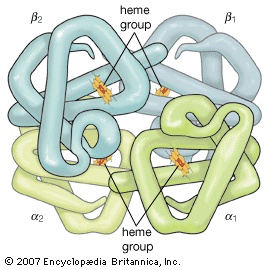hemoglobin
biochemistry
also spelled haemoglobin
 iron-containing protein in the blood of many animals—in the red blood cells (erythrocytes (erythrocyte)) of vertebrates—that transports oxygen to the tissues. Hemoglobin forms an unstable, reversible bond with oxygen; in the oxygenated state it is called oxyhemoglobin and is bright red; in the reduced state it is purplish blue.
iron-containing protein in the blood of many animals—in the red blood cells (erythrocytes (erythrocyte)) of vertebrates—that transports oxygen to the tissues. Hemoglobin forms an unstable, reversible bond with oxygen; in the oxygenated state it is called oxyhemoglobin and is bright red; in the reduced state it is purplish blue.Hemoglobin develops in cells in the bone marrow that become red blood cells. When red cells die, hemoglobin is broken up: iron is salvaged, transported to the bone marrow by proteins called transferrins (transferrin), and used again in the production of new red blood cells; the remainder of the hemoglobin forms the basis of bilirubin, a chemical that is excreted into the bile and gives the feces their characteristic yellow-brown colour.
Each hemoglobin molecule is made up of four heme groups surrounding a globin group, forming a tetrahedral structure. Heme, which accounts for only 4 percent of the weight of the molecule, is composed of a ringlike organic compound known as a porphyrin to which an iron atom is attached. It is the iron atom that binds oxygen as the blood travels between the lungs and the tissues. There are four iron atoms in each molecule of hemoglobin, which accordingly can bind four atoms of oxygen. Globin consists of two linked pairs of polypeptide chains.
Hemoglobin S is a variant form of hemoglobin that is present in persons who have sickle cell anemia, a severe, hereditary form of anemia in which the cells become crescent-shaped when oxygen is lacking. The sickling trait is found almost exclusively in people of African descent.
- Aleksandr Osipovich Gelfond
- Aleksandrov, Pavel Sergeevich
- Aleksandrovsk-Sakhalinsky
- Aleksandr Petrovich Sumarokov
- Aleksandr Popov
- Aleksandr Scriabin
- Aleksandr Semyonovich Shishkov
- Aleksandr Sergeyevich Griboyedov
- Aleksandr Sergeyevich, Knyaz Menshikov
- Aleksandr Sergeyevich Menshikov, Knyaz
- Aleksandr Sergeyevich Pushkin
- Aleksandr Sergeyevich Yakovlev
- Aleksandr Stepanovich Grin
- Aleksandr Vasilyevich Kolchak
- Aleksandr Vasilyevich Medved
- Aleksandr Yakovlevich Tairov
- Aleksandŭr Stamboliyski
- Aleksandŭr Tsankov
- Aleksei Gogua
- Aleksey Alekseyevich Brusilov
- Aleksey Andreyevich Arakcheyev, Graf
- Aleksey Andreyevich, Graf Arakcheyev
- Aleksey Andreyevich Polivanov
- Aleksey Arkhipovich Leonov
- Aleksey Borisovich, Knyaz Lobanov-Rostovsky